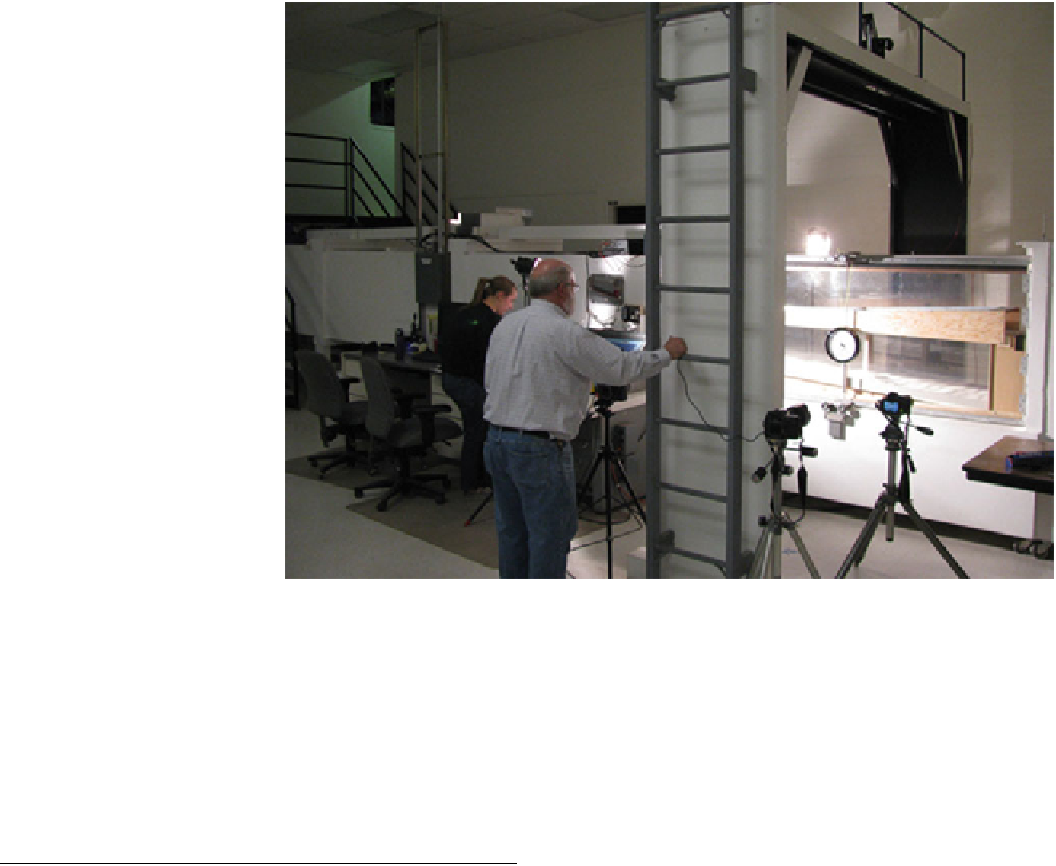Geoscience Reference
In-Depth Information
Fig. 17.3
The aeolian processes
wind tunnel at ASU, with a
plexiglass working section. Note
the lights and cameras. Photo
courtesy Rob Sullivan
the emitted light are easily discriminated). These techniques
rely on somewhat empirical calibrations of how many
trapped electrons are generated per unit time, for a given
material (like quartz or feldspar) in a given environment
(the cosmic ray dose depends on altitude, and the amount of
radioactive elements like thorium or uranium in the sand).
OSL especially has become a widely-used technique in
paleoclimate and dune evolution studies.
to the naked eye, the streaking trajectory of a grain gives
only a short effective exposure time which makes photog-
raphy challenging, so he had to install a specially intense
arc light to photograph the grain trajectories (shown sche-
matically in Fig.
4.1
). Modern digital cameras, xenon lamps
(e.g., Fig.
17.3
) and laser light sheets now make this sort of
observation (e.g., Fig.
17.4
) much more straightforward,
and remarkable close-up pictures showing the rotation of
individual grains (see Fig.
4.11
) can now be taken.
Today, many wind tunnel facilities can be found in
universities and research laboratories around the world.
Notable aeolian facilities include the wind tunnels at Iowa
State University (Fig. 3.7a of Greeley and Iversen 1985)
and at Arizona State University (Figs.
17.3
and
17.5
), which
have been used by Iversen and Greeley (respectively) to
conduct a wide array of experiments; another example is the
sediment transport tunnels at the University of Guelph and
nearby Trent University in Canada. A commercially oper-
ated tunnel is also operated in Guelph to study wind loads
on buildings and also to estimate where blown snow
deposition may occur, which can be a structural danger.
While the instrumentation has changed dramatically, the
basic measurements obtained from modern wind tunnels
remain quite similar to those obtained by Bagnold. Sensors
for measuring the wind velocity as a function of height
above the test surface remain the most essential requirement
for monitoring any wind tunnel run, augmented by spe-
cialized instruments for whatever the specific question is
being investigated. Recently, it has become quite common
for portable wind tunnels to be deployed in field settings,
17.2
Process: Terrestrial Wind Tunnels
Any discussion of the instrumented study of aeolian pro-
cesses typically must begin with Bagnold's now classic
measurements of wind conditions and their effect on the
movement of sand, as described in his seminal 1941 book.
Bagnold built a wind tunnel at his home where different
segments of the tunnel floor could be weighed individually
during a simulation run. This allowed him to generate the
first quantitative measurements of sand flux under diverse
but controlled wind conditions, which he could compare
though these represent the first quantitative aeolian mea-
surements, nearly all of his results have stood the test of
time when compared with modern measurements, a testa-
ment to the great care Bagnold devoted to the various
measurements he made.
Bagnold devotes three pages of his book just to the
illumination he used in his tunnel in order to photograph the
trajectories of saltating grains. As he notes, although visible

Search WWH ::

Custom Search